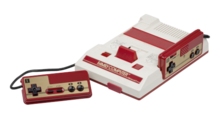
Back NES AN نينتندو إنترتينمنت سيستم Arabic نينتيندو انترتينيمنت سيستم ARZ Nintendo Entertainment System AST Nintendo Entertainment System Byelorussian Nintendo Entertainment System Breton Nintendo Entertainment System BS Nintendo Entertainment System Catalan سیستمی چێژبەخشی نینتێندۆ CKB Nintendo Entertainment System Czech
 | |
Top: NES Control Deck (with detachable controllers) Bottom: Family Computer ("Famicom") main unit (with hardwired controllers) | |
| Also known as | Family Computer/Famicom (Japan) Hyundai Comboy (South Korea) Samurai Electronic TV Game System (India) Dendy (Post-Soviet countries) Nintendo Entertainment System (PAL A/PAL B/Southeast Asia) |
|---|---|
| Developer | Nintendo R&D2 |
| Manufacturer | Nintendo |
| Type | Home video game console |
| Generation | Third |
| Release date | |
| Introductory price | ¥14,800 (equivalent to ¥18,365 in 2019) US$179 (equivalent to $510 in 2023)[4] |
| Discontinued | [6] |
| Units sold | 61.91 million[7] |
| Media | Nintendo Entertainment System Game Pak |
| CPU |
|
| Memory | 2 KB work RAM 2 KB video RAM 256 bytes sprite RAM |
| Display | 256 × 240 px |
| Graphics | PPU (Ricoh 2C02) |
| Sound | APU, 5 channels: 2 pulse wave, triangle wave, white noise, DPCM |
| Controller input | 2 controller ports[d] 1 expansion slot |
| Best-selling game |
|
| Predecessor | Color TV-Game |
| Successor | Super NES |
| Related | Famicom Disk System, Famicom 3D System |
The Nintendo Entertainment System (NES) is an 8-bit home video game console produced by Nintendo. It was first released in Japan on July 15, 1983, as the Family Computer (Famicom).[note 1] It was released in US test markets as the redesigned NES in October 1985, and fully launched in the US the following year. The NES was distributed in Europe, Australia, and parts of Asia throughout the 1980s under various names. As a third-generation console, it mainly competed with Sega's Master System.
The NES was designed by Masayuki Uemura. Nintendo's president, Hiroshi Yamauchi, called for a simple, cheap console that could run arcade games on cartridges. The controller design was reused from Nintendo's portable Game & Watch hardware. The western model was redesigned to resemble a video cassette recorder. Nintendo released add-ons such as the NES Zapper light gun for several shooting games, and R.O.B, a toy robot accessory.
The NES is regarded as one of the most influential consoles. It helped revitalise the American gaming industry following the video game crash of 1983,[e] and pioneered a now-standard business model of licensing third-party developers to produce and distribute games.[11] The NES features several groundbreaking games, including Super Mario Bros. (1985), The Legend of Zelda (1986), Metroid (1986), and Mega Man (1987) which have become major franchises.
The NES dominated Japanese and North American markets, but initially underperformed in Europe where it faced strong competition from the Sega Master System and microcomputers. With 61.91 million units sold, it is one of the best-selling consoles of all time. It was succeeded in 1990 by the Super Nintendo Entertainment System.
- ^ Kohler, Chris (October 18, 2010). "Oct. 18, 1985: Nintendo Entertainment System Launches". WIRED. Archived from the original on November 26, 2020. Retrieved June 11, 2015.
- ^ Top Hat Gaming Man (April 28, 2019). Hyundai Super Comboy – The Story of The Super Nintendo Console in South Korea!. Event occurs at 7:48. Archived from the original on June 26, 2023 – via YouTube. [unreliable source]
- ^ "Video Games Around the World: South Africa". Archived from the original on September 25, 2022. Retrieved September 25, 2022.
- ^ Levin, Martin (November 20, 1985). "New components add some Zap to video games". San Bernardino County Sun. p. A-4.
- ^ "Nintendo Entertainment System (NES) – 1985–1995". Classic Gaming. GameSpy. Archived from the original on October 29, 2012. Retrieved December 20, 2019.
- ^ "編集者の目/企業者からのメッセージ". 任天堂株式会社. Archived from the original on April 13, 2004. Retrieved January 11, 2025.
- ^ a b "Consolidated Sales Transition by Region" (PDF). Nintendo. March 2016. Archived (PDF) from the original on April 27, 2016. Retrieved September 12, 2022.
- ^ Stuart, Keith (September 13, 2010). "Super Mario Bros: 25 Mario facts for the 25th anniversary". The Guardian. Archived from the original on August 9, 2017. Retrieved November 2, 2018.
- ^ Goss, Patrick. "The games that sold consoles". MSN. Archived from the original on March 9, 2008. Retrieved September 24, 2011.
- ^ a b Sheff, David (1993). Game Over. New York: Random House. ISBN 0-679-40469-4. Retrieved July 2, 2019.
- ^ Sanchez-Crespo, Daniel (September 8, 2003). Core Techniques and Algorithms in Game Programming. New Riders Games. p. 14. ISBN 0-13-102009-9.
Cite error: There are <ref group=lower-alpha> tags or {{efn}} templates on this page, but the references will not show without a {{reflist|group=lower-alpha}} template or {{notelist}} template (see the help page).
Cite error: There are <ref group=note> tags on this page, but the references will not show without a {{reflist|group=note}} template (see the help page).

